Dive into the heritage of Roman cuisine with this 4-ingredient Pasta Alla Gricia recipe. The age-old blueprint for classics like carbonara and amatriciana combines pasta, guanciale, pecorino romano, and black pepper into a dish that's rich in history and flavor!
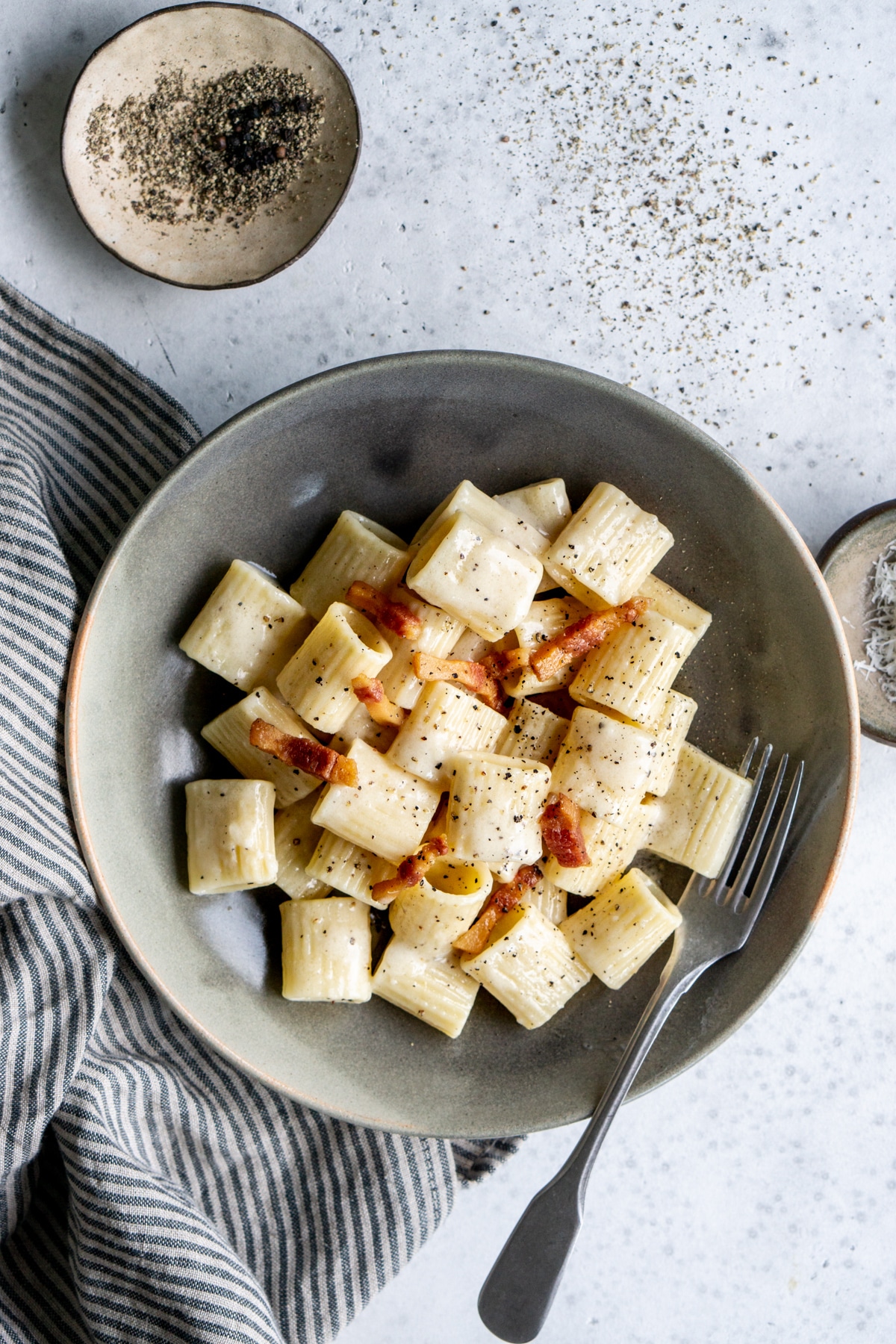
As a seasoned Italian cook, not only do I love making authentic Italian dishes in my kitchen, but I love the history that surrounds them, too! Pasta alla Gricia is the original Roman pasta.
This classic pasta recipe predates the tomato-infused pasta amatriciana before tomatoes became a staple in Italian cuisine in the 1800s. Time-honored, Gricia's savory simplicity continues to hold a place at the Italian table.
I have to say something controversial: gricia is tied for my favorite of the roman pasta dishes. I like it better than carbonara and cacio e pepe, and it only maybe comes second to pasta amatriciana.
In my opinion, once you taste gricia, you realize that the carbonara doesn't need the eggs (because that's exactly what gricia is - a carbonara without the eggs). Without the addition of the eggs, the flavors of the pecorino and guanciale in gricia are more pronounced. And while cacio e pepe is an amazing dish, the guanciale in the gricia just adds a little extra special something, and makes the dish more interesting.
I love serving pasta alla gricia with a simple Italian side dish, like roman artichokes, or escarole with raisins and pine nuts.
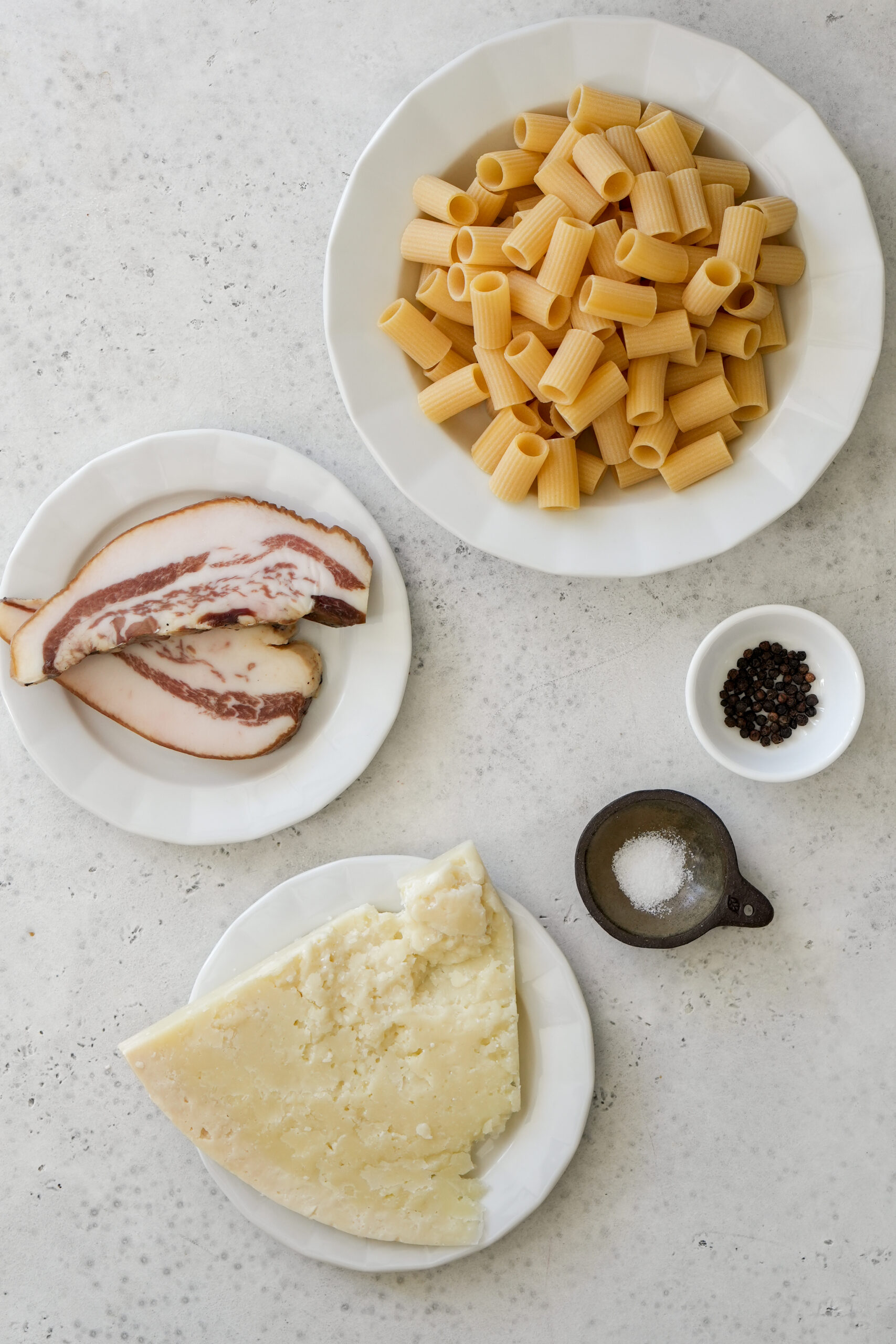
Few ingredients
- Mezze Maniche Pasta - Spaghetti is the most traditional pasta to use for this dish, but I love using this short version of rigatoni.
- Guanciale - Cured pork cheek cut into strips brings a delicate texture and a deep, rich flavor that's the backbone of the dish. It is similar to the taste of bacon with a high-fat content that melts right into the dish.
- Pecorino Romano - A hard, salty sheep cheese that, when grated, melts into a creamy, tangy element, binding everything together.
- Salt and Pepper - Essential seasonings that heighten the dish's flavors, with salt bringing out the pasta's wheaty taste and pepper adding a warm, spicy note.

How to make it
Cook the guanciale in a pan, and once done, remove, but keep the rendered guanciale fat in the pan.
Drain the pasta and add it to the pan with the pork fat, and some pasta water. Let the pasta finish cooking to al dente.
Make a cheese paste: add the grated pecorino romano to a bowl. Pour in some pasta water and mix until a paste is formed.

Remove the pasta from the heat and add the cheese paste, and mix everything together. Add pasta water if needed. Add the ground black pepper.
Add the cooked guanciale and mix until combined. Plate while hot and garnish with more cracked black pepper and additional pecorino romano. Enjoy!
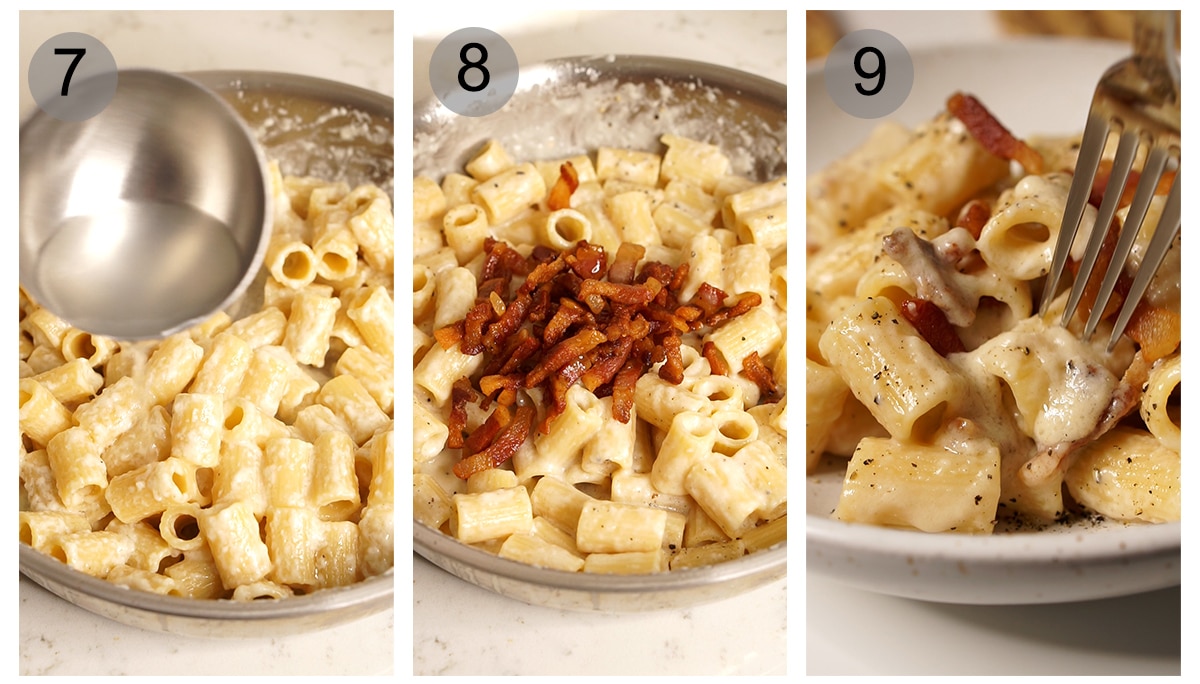
Tips
- I recommend to weigh the pecorino as opposed to measure it in cups - this will give you a more accurate measurement and ensure you're using the correct amount of cheese (because everyone grates cheese differently, which will affect the cup measurement)
- Undercook your pasta by 2 minutes less than the package instructions; it will continue cooking in the sauce, ensuring it doesn't get mushy.
- Before draining, save a cup of pasta water; its starchiness is perfect for adjusting the sauce's consistency.
- Cook the guanciale over medium heat to render out the fat without burning, giving you crisp pieces and a flavorful fat base for the sauce.
- Ensure to cook the pasta in the pan with the guanciale fat for at least a few minutes so the starch releases into the pan.
- To prevent clumping, make sure the pecorino is finely grated and create a paste with some pasta water before adding it to the pan, ensuring a smoother integration with the pasta. Also keep adding pasta water to get the sauce to a smooth consistency.
- Be careful when first transferring the pasta to the pan – because water mixed with the guanciale fat will splatter.
- This dish is naturally very salty due to the use of pecorino romano and guanciale, which contain a lot of salt. Besides lightly salting the pasta water, there is no need to add additional salt to this dish. Be prepared for this dish to be on the salty side.

Storing
Storing: Allow the dish to cool to room temperature before transferring it to an airtight container. It will keep well in the refrigerator for up to 3 days. When reheating, gently warm it in a pan over low heat, adding a splash of water to help the sauce regain its creamy consistency.
Recipe
Authentic Italian Pasta Alla Gricia Recipe
Ingredients
- 250 grams mezze maniche pasta
- 1 cup guanciale cut into strips
- 2 ½ cups (120g) grated pecorino romano
- salt and pepper to taste
Instructions
- Bring a pot of water to boil. When it's boiling, add salt. Throw the pasta in and cook until it's before al dente (Cook for about half the indicated time on the package)– this is important because the pasta will finish cooking in the sauce. Be sure to reserve some pasta water.
- Just before the pasta boils and you throw the pasta into the water, throw the guanciale into a large cold pan that will also fit the pasta.
- Turn the heat up to medium and let the guanciale cook until crispy - about 10-15 minutes. Remove from the pan, but keep the rendered fat in. If the pasta isn't ready by this time, remove from the burner.
- Add the al dente pasta to the pan (still over medium heat) with the rendered guanciale fat. Add a ladle of pasta water as well.
- While the pasta is finishing in the pan, place the grated pecorino in a bowl, and add a bit of pasta water to it. Mix with a fork until a paste forms.
- Let the pasta cook for a few minutes until cooked to desired consistency (al dente), so it releases its starches and a creamy consistency starts to form when mixed with the guanciale fat. Add more pasta water if needed. There should be a little bit of liquid left at the bottom of the pan, it shouldn't be completely dry. Remove the pan from the heat.
- Add the pecorino paste to the pasta. Mix with a wooden spoon.
- If the pecorino cream needs to be thinned out a bit more, add more pasta water. Add the ground black pepper.
- Add the gunaciale and mix again until evenly distributed in the pasta.
- Plate, top with additional black pepper and grated pecorino if desired. Enjoy!

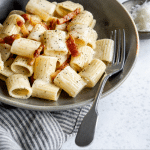
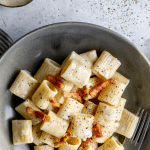


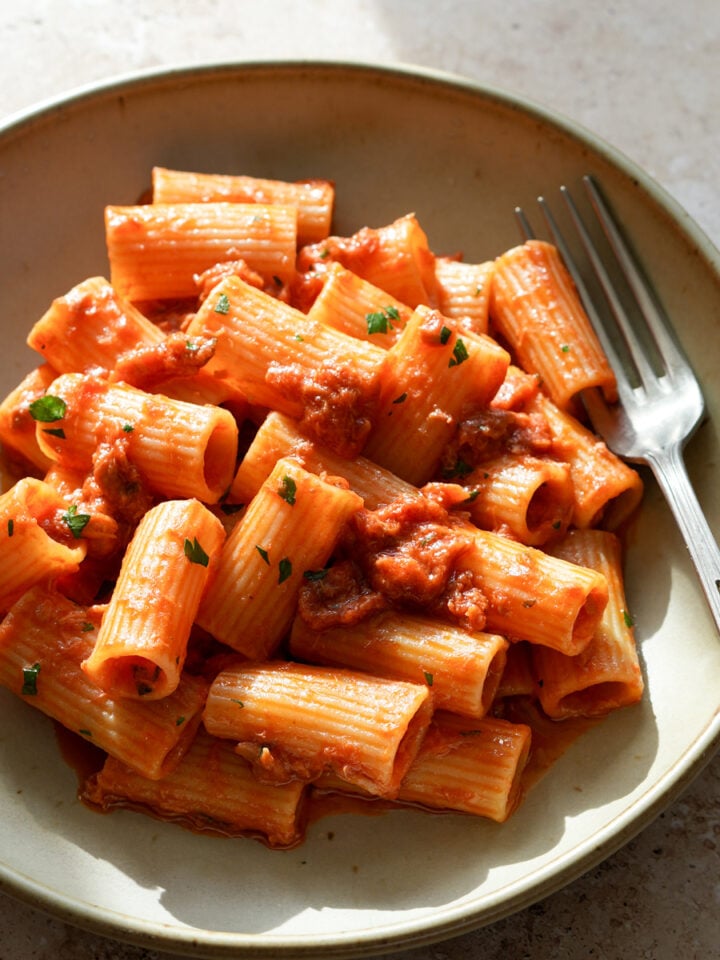
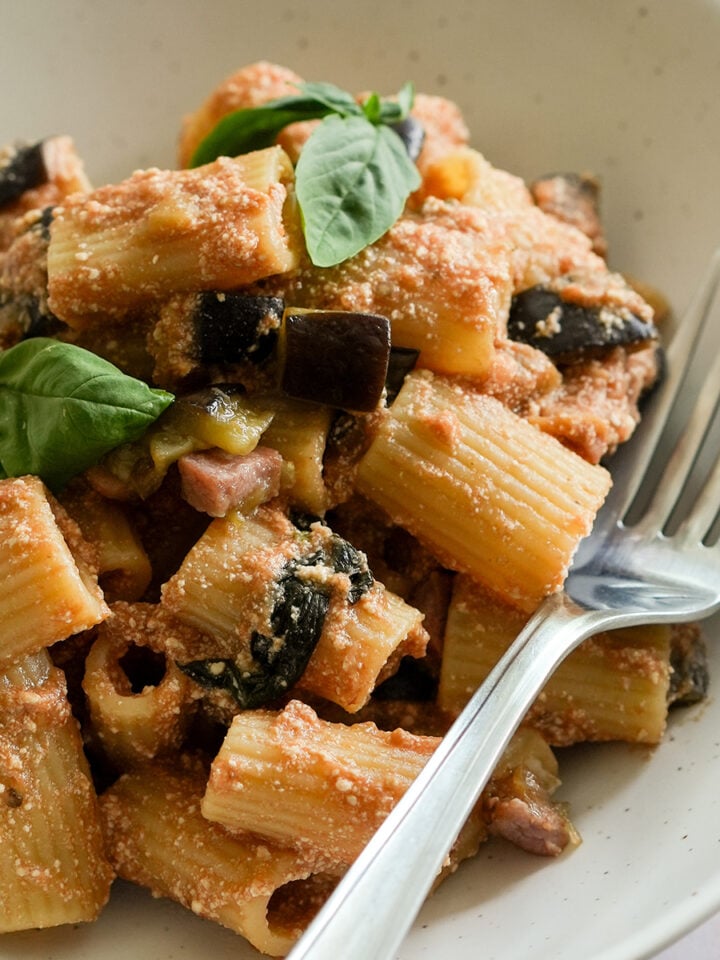
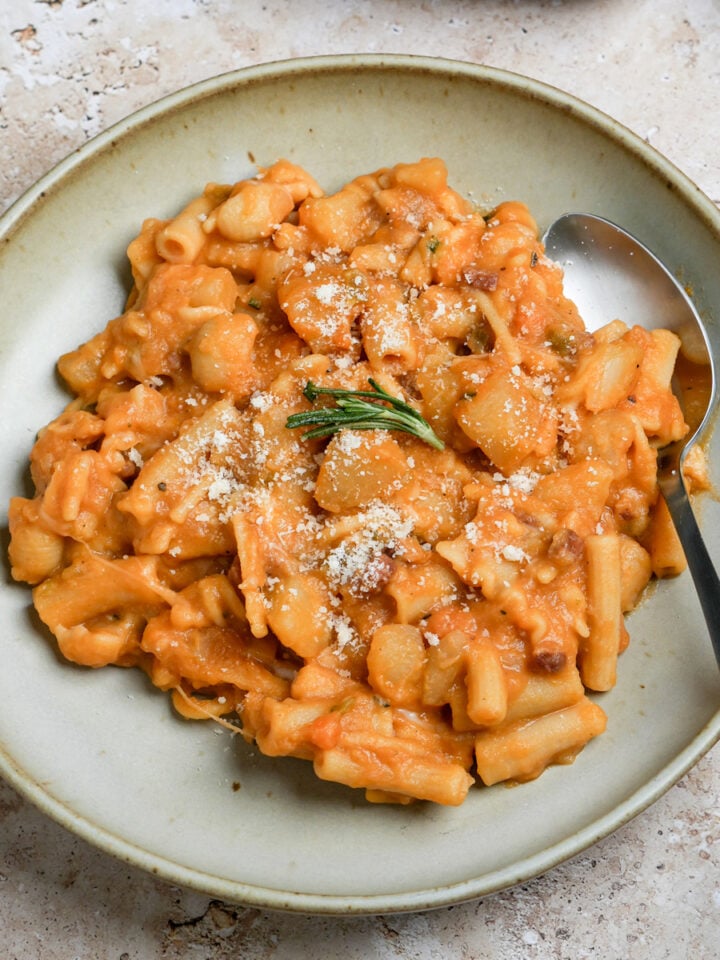

Dave Barnes says
not 1800’s, but 1800s
Brought to You by the Committee to Save the Apostrophe from Abuse
Jo says
Pina,
I love your recipes! But, I cannot find guanciale anywhere near me! Is there a way to order it online, or is substituting with pancetta okay??
All the best,
Jo
Pina says
Hi Jo! Yes, pancetta is a perfectly fine substitute. Just make sure to add a little oil when cooking it as I find it needs some help to cook down.
-Pina
ellie says
Just want to say that this was amazing! So simple but amazing flavors and textures worthy of a dinner party. I really appreciate the clear instructions and photos as a guide. So happy I found your blog!
Pina says
Thanks Ellie! I am so glad you liked it!
-Pina
Valerie C says
We recently visited Italy and I had Pasta Alla Gricia there. I found myself thinking about it and wishing I could have it again. I found your recipe and it did not disappoint. The flavors and textures were almost identical to what I had in Rome. So delicious. And I was delighted to find it was not a difficult dish to make. Your instructions and pictures were so helpful. My husband said we can put this in our regular dinner recipe rotation!
Pina says
Thank you Valerie! I'm so glad you liked it. Roman pasta dishes are the best - I'm glad this version reminds you of the one you had in Rome.